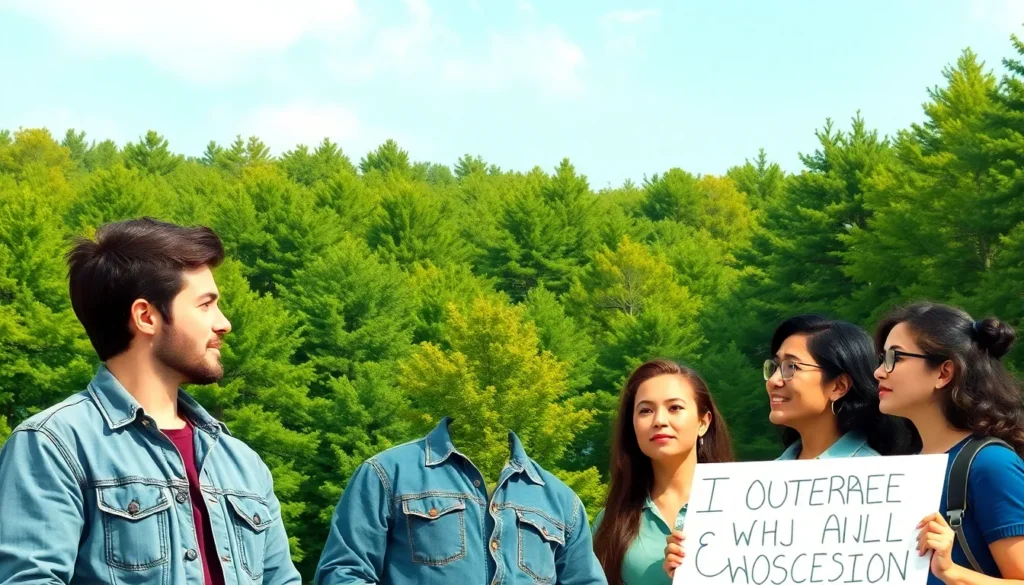Table of Contents
ToggleIn the grand arena of legal battles, few cases have sparked as much debate as Babbitt v. Sweet Home Chapter of Communities for a Great Oregon. Picture this: a showdown between the government and a logging company, with the fate of endangered species hanging in the balance. It’s like a courtroom drama mixed with a nature documentary, where the stakes are high and the players are anything but ordinary.
This landmark case delves deep into the Endangered Species Act and challenges the definition of “take.” What does it really mean to harm a species? As the courtroom echoes with arguments, it’s not just about trees and critters; it’s about the balance between conservation and commerce. Buckle up as we unravel the twists and turns of this pivotal case that continues to shape environmental law and policy.
Background of Babbitt V Sweet Home
Babbitt v. Sweet Home Chapter of Communities for a Great Oregon represents a pivotal moment in environmental law. This case involves contrasting interests in conservation and commercial resource management.
Significance of the Case
The significance of Babbitt v. Sweet Home lies in its interpretation of the Endangered Species Act. The Supreme Court decided that the term “take” includes actions that harm species, even if the harm results from habitat modification rather than direct killing. This ruling expanded protections for endangered species, influencing future conservation efforts. Stakeholders in the timber industry and environmental organizations closely monitored the case. Its outcome shaped policy debates regarding land use and environmental protections nationwide.
Key Parties Involved
Key parties in the case included the U.S. government and the Sweet Home Chapter of Communities for a Great Oregon. The U.S. government aimed to enforce the Endangered Species Act, emphasizing the importance of protecting threatened species. Conversely, the logging company argued that the law’s interpretation unfairly restricted their operations. The timber industry’s concerns highlighted the tension between economic activities and environmental preservation. Various environmental groups supported the government’s position, advocating for stronger safeguards for wildlife. Each party’s stance underscored the broader implications of balancing ecological needs with commercial interests.
Legal Context

The legal framework surrounding Babbitt v. Sweet Home centers on the Endangered Species Act (ESA) and its implications for environmental protection.
The Endangered Species Act
The Endangered Species Act, established in 1973, seeks to protect critically endangered species and their habitats. This legislation prohibits the “take” of endangered species, which the Supreme Court expanded to include habitat modification. Under this law, actions impacting species survival, even indirectly, fall under regulatory scrutiny. It aims to balance development and conservation by emphasizing species recovery through protective measures. Significant penalties exist for violations, highlighting the government’s commitment to biodiversity conservation.
Previous Related Cases
Several cases prior to Babbitt v. Sweet Home have shaped legal interpretations of the ESA. Tennessee Valley Authority v. Hill addressed the importance of upholding the act even in the face of economic implications. Similarly, Sierra Club v. Morton highlighted the need for environmental protection before economic interests. These cases contributed to a legal precedent affirming the principle that habitat destruction poses a substantial threat to endangered species. Through these decisions, courts reinforced the idea that economic activities must consider environmental impacts.
Case Development
Significant developments unfolded throughout the Babbitt v. Sweet Home case, shaping its judicial trajectory. This section outlines the initial rulings and the appeals process that followed.
Initial Rulings
The U.S. District Court initially ruled in favor of the U.S. government. The court determined that habitat modification constituted a “take” under the Endangered Species Act. This broader interpretation emphasized protecting endangered species beyond direct harm. Following that, the Ninth Circuit Court of Appeals upheld the decision, reinforcing the idea that actions impacting habitats could violate federal law. Environmental groups celebrated these rulings, recognizing their importance in addressing conservation issues. The court’s rulings thus expanded the scope of responsibility for industries interacting with endangered species’ environments.
Appeals Process
Following the Ninth Circuit’s ruling, the logging company sought further recourse, appealing to the Supreme Court. Oral arguments highlighted the tension between commercial interests and environmental protections. The Supreme Court agreed to hear the case, drawing significant attention from legal experts and environmental advocates. In 1995, the Supreme Court ultimately upheld the Ninth Circuit’s decision. This affirmed its interpretation of the “take” definition within the Endangered Species Act, consolidating its precedent-setting impact. The appeals process further underscored the complexities involved in balancing economic activities with ecological conservation.
Implications of the Ruling
The ruling in Babbitt v. Sweet Home has far-reaching consequences for both environmental law and regulatory practices. The Supreme Court’s interpretation of “take” under the Endangered Species Act significantly shaped conservation efforts across the United States.
Environmental Impact
The decision clarified that habitat modification can endanger species, expanding the definition of “take” significantly. Wildlife populations, often suffering due to habitat destruction, gained new layers of protection. Proposals for development projects now face additional scrutiny, requiring assessments of potential impacts on local ecosystems. By mandating considerations for indirect harm, the ruling fostered a more comprehensive approach to environmental responsibility. Conservation groups embraced this broader interpretation, viewing it as a crucial victory for species at risk.
Legal Precedents Established
This case established important legal precedents that influence subsequent interpretations of the ESA. Courts began to recognize the relationship between habitat health and species survival more rigorously. Informed by the ruling, judges have leaned towards broader definitions in similar cases, solidifying protections for endangered species. The precedent set here encourages future legal challenges against activities threatening ecosystems. Legal scholars acknowledge Babbitt v. Sweet Home as a landmark case, shaping the trajectory of environmental policy in the U.S.
Public and Expert Reactions
Babbitt v. Sweet Home generated diverse responses from the public and experts, reflecting the case’s profound impact on environmental law.
Support for the Ruling
Many environmental groups celebrated the Supreme Court’s decision as a significant victory for wildlife protection. Organizations like the Sierra Club emphasized that this ruling strengthened the Endangered Species Act by clarifying definitions that promote habitat preservation. This broader interpretation of “take” ensures that activities jeopardizing habitats face legal scrutiny, allowing for healthier ecosystems. Conservationists noted the decision’s potential to deter harmful practices, advocating sustainable land use. Consequently, the ruling provided a framework for evaluating future development projects, ensuring they align with ecological preservation goals.
Criticism and Concerns
Some industry stakeholders expressed concern about the implications of the ruling on economic activities. Logging companies, in particular, argued that the interpretation of “take” could hinder their operations, citing potential job losses and economic downturns. Critics claimed that the decision creates burdensome regulations for landowners with little regard for economic viability. They highlighted fears that the ruling might be misused to block legitimate projects without proper justification. Consequently, business groups called for clearer definitions within the ESA to balance economic interests with environmental conservation effectively.
Babbitt v. Sweet Home stands as a landmark case that reshaped the landscape of environmental law in the United States. By expanding the definition of “take” to include habitat modification, the Supreme Court’s ruling emphasized the necessity of protecting endangered species and their habitats. This pivotal decision not only influenced future conservation efforts but also sparked ongoing debates about the balance between economic activities and environmental preservation. As stakeholders continue to navigate the complexities of the Endangered Species Act, the implications of this case remain relevant, highlighting the critical need for responsible land use and sustainable practices. The legacy of Babbitt v. Sweet Home will undoubtedly continue to guide legal interpretations and policy decisions in the years to come.







